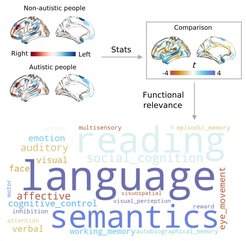Functional brain organisation altered in autism
Autism is a complex and multifaceted neurodevelopmental condition. Often, people with autism have altered information and perceptual processing in the brain, which alters the development of social interaction, communication and behavioural repertoires. Thus, compared to non-autistic individuals, they show subtle changes in the asymmetry of the brain structure and a lower laterality of functional activation, in terms of the use of the left or right hemisphere in the brain. Bin Wan and Sofie Valk from the Max Planck Institute for Human Cognitive and Brain Sciences in Leipzig and Forschungszentrum Jülich (Germany), together with international researchers from South Korea, UK, Switzerland, and Canada, have now investigated in a study whether such functional asymmetries in autism are indicative of altered systematic organisation in the brain in general.
Autism is characterised by lifelong differences in social interaction and communication, as well as restricted and repetitive interests and behaviours. The widespread behavioural alterations observed in people with autism are accompanied by reports of structural and functional changes in the sensory and associative regions of the brain. Researchers locate one cause in altered patterns of brain asymmetry, possibly related to atypical lateralisation of functional processes. "Asymmetry is a key feature of brain organisation, supporting flexible interplay between local neuronal modules linked to the functional specialisation that underlies human cognition," explains Bin Wan, lead author of the study.

The researchers analysed brain scan data from 140 autistic individuals and 143 non-autistic individuals aged five to forty years to investigate system-level imbalances in the hemispheres in autism. "When segregating unimodal and transmodal systems, reduced left-directed functional asymmetry of language network organisation was observed in individuals with autism compared to non-autistic individuals. While the asymmetry of language networks varied across age groups in the latter, this was not the case in autism. This may suggest that the atypical functional laterality in autism results from altered developmental trajectories." In addition, the researchers found that lateralisation features can predict the strength of autistic traits.

Sofie Valk, head of the Cognitive Neurogenetics research group at MPI CBS, classifies: "Taken together, our work shows that there are subtle differences in the asymmetry of functional organisation in autistic and non-autistic individuals. These differences may be rooted in development and vary from person to person. The results suggest that both genetic and environmental components may be important in this context. Future work would now need to examine the effects of environmental factors on genes associated with autism during early development and cognitive development across the lifespan."













